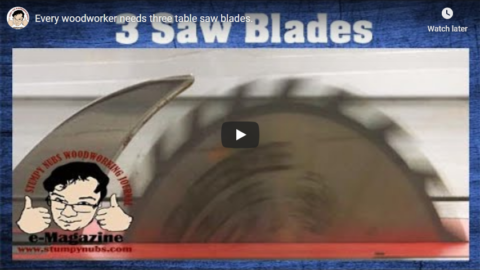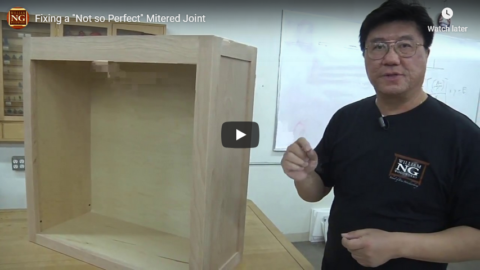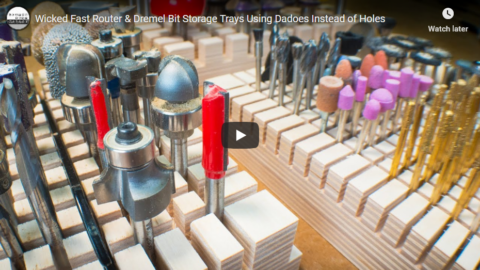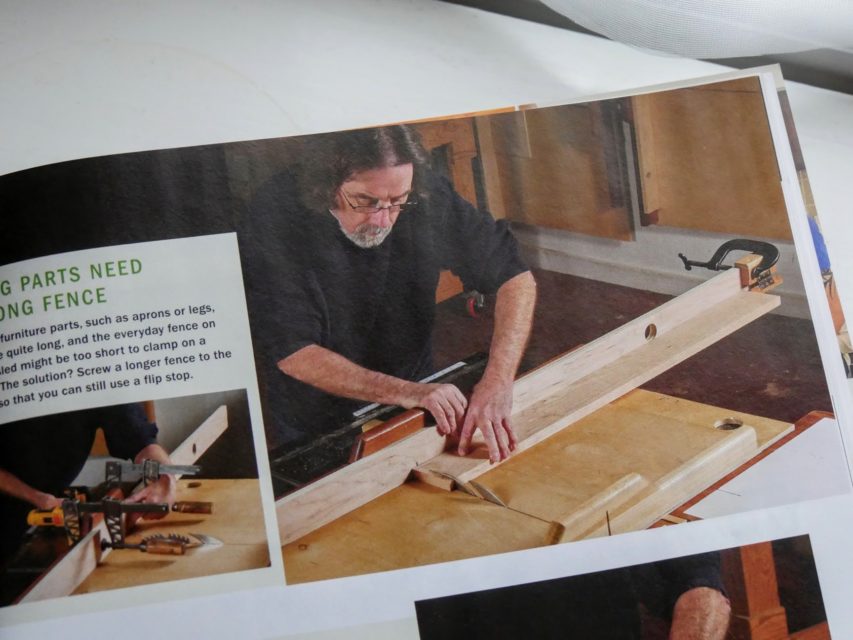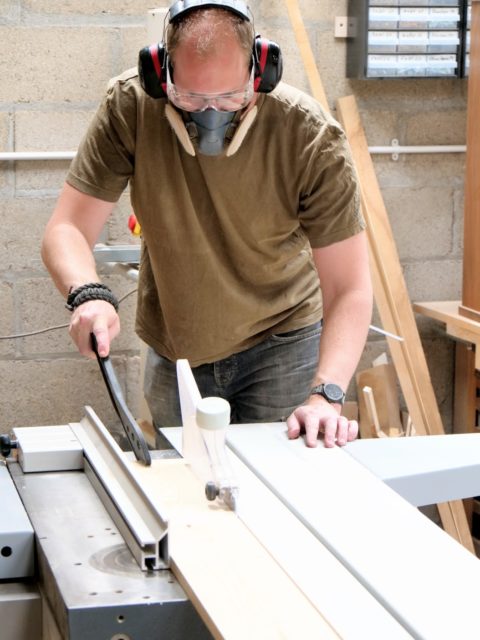Stumpy Nubs
Published 5 Dec 2020It’s cheap, fast and easy to build, and it works flawlessly!
When you use this link to visit our sponsor, you support us►
Ridge Carbide (Use coupon code SNWJ10): https://goo.gl/z8TP0k
Subscribe (free) to Stumpy Nubs Woodworking Journal e-Magazine► http://www.stumpynubs.com/subscribe.htmlFollow us on social media►
Instagram: https://www.instagram.com/stumpynubs/
Twitter: https://twitter.com/StumpyNubs
March 10, 2021
CHEAP and EASY three-Minute finger/box joint jig
November 23, 2020
Every woodworker need three table saw blades
Stumpy Nubs
Published 20 Aug 2020-Your table saw isn’t the problem, you’re using the wrong blade!
More links to help you►
Video about blade tooth features: https://youtu.be/0J1pRBiVKbI
Video about specialty joinery blades: https://youtu.be/PZXg5KA0P-Q
Video about dado sets: https://youtu.be/Ex4UgxzaB0Q
Video about setting blade height: https://youtu.be/JL8-1bmt7XY
Video about thin kerf vs. full kerf: https://youtu.be/s0UtOpRRaO4When you use this link to visit our sponsor, you support us►
Ridge Carbide (Use coupon code SNWJ10): https://goo.gl/z8TP0kSubscribe (free) to Stumpy Nubs Woodworking Journal e-Magazine► http://www.stumpynubs.com/subscribe.html
Follow us on social media►
Instagram: https://www.instagram.com/stumpynubs/
Twitter: https://twitter.com/StumpyNubs
September 28, 2020
Fixing a “Not so Perfect” Mitered Joint
William Ng
Published 26 Dec 2011Making miter joints are never easy, especially on long cuts. Here is a simple technique that can cover up a multitude of sins. it will also take some of the stress out of cutting perfect miters. This technique saved me a few time when I was making miters for Pantry cabinets and Home Theaters where the length of cuts are close to 8 feet.
June 26, 2019
Wicked Fast Router & Dremel Bit Storage Trays Using Dadoes Instead of Holes
Keith’s Test Garage
Published on 30 Mar 2019How to make organizer trays for router and Dremel bits by cutting dadoes on the table saw instead of drilling holes.
May 12, 2019
CRAZY easy way to straighten a rough board or cut a taper
Stumpy Nubs
Published on 9 Apr 2019When you use this link to visit our sponsor, you support us►
SaburrTooth Carving Tools: http://www.saburrtooth.com/
Subscribe (free) to Stumpy Nubs Woodworking Journal e-Magazine► http://www.stumpynubs.com/subscribe.html
September 11, 2017
5 Woodworking Cuts You Need to Know How to Make | WOODWORKING BASICS
Published on 9 Jun 2017
Sometimes the terminology gets confusing, so in this BASICS episode, I’ll break down the 5 basic types of woodworking cuts and how to make them.
September 2, 2017
Making zero clearance table saw inserts
Published on 13 May 2012
Showing the steps for making a zero clearance table saw insert
http://woodgears.ca/delta_saw/insert.html
July 16, 2017
Woodworking magazines and the lack of safety equipment in photos
I’ve bought hundreds of woodworking magazines over the years, and in almost every one of them they show machine tool operations where the blade guards have been removed “to clearly illustrate the task”. I understand that reasoning, but the cumulative effect of literally thousands of well-posed, clear, and dangerous practices is almost certainly to lessen the background awareness of new woodworkers to safe use of the tools. When I first got into woodworking, I was buying at least half a dozen magazines every month (ShopNotes, Woodsmith, Popular Woodworking, Fine Woodworking, Woodworker’s Journal, etc.) because I hadn’t touched a real woodworking tool since I was in middle school (and I hated shop at that time anyway), and I knew I needed as much help as I could get.
If I hadn’t been a safety wuss, I’d likely have internalized the “common wisdom” that everyone always takes off the blade guard of the table saw — because they so rarely showed up in the magazine articles and when they did, they made the photo less helpful because of the area of the work they obscured. Overheard conversations at woodworking shows often included comments about throwing away the stock blade guard as soon as possible … and not to replace it with an expensive after-market item, either.
Paul Sellers, who generally works with hand tools, has also been irritated by this and his latest blog post takes the magazines to task:
I thumbed through recent issues of wood mags and though I have known it for years, I thought it might be good to tackle the giant issue surrounding machine safety as some woodworking magazines don’t always project the right image. In fact some give the impression that no safeguards or safety equipment is necessary at all, the exact opposite of what the woodworking machine industry teaches altogether. My concern is that the woodworking magazines get most of their support from amateur woodworkers looking for guidance and inspiration. This advertising sector caters to the amateur woodworker industry with only a little crossover into professional realms. Thumbing through the magazines I was not really considering safety at all, just looking for content of interest to me, but I soon became conscious of the lack of safety equipment being used, which started my inbuilt alarm bells started ringing page after page. See if the images below don’t cause the same sense of concern for you.
[…]
So here we are, five images spanning a few pages with not a face shield in sight and only one pair of safety glasses between four of the five images. Then we have zero regard for any dust protection issues and that is of great concern to all woodworkers. Now I know you can say to me that all woodworkers know about machine dust, tablesaw kick-back issues, noise that causes partial impairment and even permanent hearing loss and so on. Of course that is not really true at all. The people in the pictures are all professional-level woodworkers, authors, editors and so on. Evidently they don’t feel the image they convey with regards to safety is questionable. If that is so, why would we expect the amateurs and those brand new to woodworking to be conscious of dangers that are often less obvious and even well hidden.
The trip mechanism in my brain asked the question, why is it that something so unarguably dangerous as machine woodworking is presented with such passivity toward safety and with no need to show industry standards for normal health and safety protocol put together by professional bodies of the woodworking industry itself? Yes, I know all the reasonable arguments. “They are just posing and not really working.” “The machines are not switched on, perhaps, therefore there is no need to wear any safety equipment. Why would you?” Well, actually, in a couple of the images, the tablesaw is running and there is no need for anyone looking in, to believe that the others are not either anyway.
Image 1:
a: The man has no safety mask on at all b: There is no blade guard over the blade c: The man has no safety glasses on. d: The man has no protective dust mask or respirator equipment.
The dangers ever present in this scenario are: 1: He is breathing harmful dust as he works with the machine no matter how good any dust extraction is. 2: Even though there is a riving knife in place my experience has shown that the wood can still close over on the rear upthrust of the blade and and kick-back the wood at his upper body and face. 3: There is no doubt that the small offcut is a missile waiting to catch. The drafts and movement of wood often cause an upthrust on small pieces and can deliver them to the rear upthrust of the blade once detached as shown. 4: The dust from tablesaws is of course extremely fine and circulates in the atmosphere even with the best dust extraction in the world. This dust is some of the most harmful to the whole respiratory system, eyes, nasal passages and throat.
I use a tablesaw sled similar to the one shown in the photo above, and to use it I have to remove the blade guard on my saw. I’ve considered adding a plexiglass strip over the blade opening for quite some time, to provide at least some protection against offcuts being kicked back from the back of the saw blade. I always use hearing protection when using any of my power tools, but I don’t always add a dust mask unless I’m doing a lot of cutting over a short period of time. Perhaps I should reconsider that.
So why do the editors allow poses that include the faces? As far as information goes the faces or facial expressions give nothing to the reader and are inconsequential. Mostly it’s to do with presenting the acceptable image that down plays the essentiality of safety to its core audience. In my view it is of little value to put a little disclaimer in the corner of a page if the images send another message that woodworking without protective equipment is perfectly safe. No one is exempted from responsibility in this. Not the authors, the photographers, the editors or the publishers. They all have responsibility for promoting unsafe practices. Even with safety equipment things go wrong in a split second. We can take care of our lungs, eyes and faces with very low-maintenance equipment.
My advice to any new woodworker wanting to compliment their work by using machines for dimensioning stock would be to find courses tailored to specific machines. Good online material is available from recognised institutions too. You must be careful of course, as looking for information based on good experience can be hard as some things are based more on opinion than experience. Look for experienced teachers and organisations with the right background. Generally these are information based but then you must put into practice what you are taught and by experience you will gain the experience you need to anticipate potential issues. No one else can substitute for your individual responsibility.
July 13, 2017
Setting-up Your First Woodworking Shop Pt. 1
Published on 7 Jun 2014
http://HomegrownFurniture.com Create your own woodworking shop from scratch. In part one of this video series, woodworker Jim Thompson helps you build your very first woodworking workshop. Jim includes buying tips, craigslist tactics and tool recommendations for a new woodworker on a budget.
March 29, 2017
How to set up & tune a tablesaw
Uploaded on 29 Jun 2008
Original post on our site with additional information, plans, questions & comments: http://www.thewoodwhisperer.com/videos/tablesaw-setup-tuneup-pt-1/
Our tools are no good to us if they aren’t tuned up properly. As the “heart” of the workshop, its crucial that our tablesaws are configured to perform their best. So whether you are setting up a new saw, or tuning up your current one, this video guide will get you where you need to be. Part 1 covers three different methods for aligning the miter slot to the blade as well as a simple technique for attaching and leveling the extension wings.
March 7, 2017
7 Things To Get You Started Using A Table Saw | WOODWORKING BASICS
Published on 15 Jan 2016
If you want to make things out of wood, a table saw is one of the most useful tools you can own. If you are new to woodworking, this video will help get you started.
Kickback caught on camera video: https://youtu.be/u7sRrC2Jpp4
February 16, 2011
Another, safer, table saw design
Table saw injuries can be quite gruesome — amputation of fingers, for example — so any new technology that might make woodworkers more safe is welcome. The first innovator in the field was the SawStop, a device that could stop the spinning blade of the saw whenever it detected human skin. Mighty impressive, but none of the major manufacturers wanted to buy the technology: it increased the cost of existing saws beyond what they thought their customers would be willing to pay. The inventor had to form a company to build his own table saws instead.
A post at the Popular Woodworking blog looks at a newer device to make table saws more safe:
Ten years ago, table saws were about to change. In 2001, you could buy a cabinet saw, such as a Delta Unisaw, a Powermatic 66 or a clone of the Unisaw made in Taiwan. Or you could get a contractor’s saw, a heavy but relatively portable table saw. Benchtop saws were not a significant part of the market, and things hadn’t changed much since the end of World War II. All the saws at the time had one thing in common: awful guards that were rarely used. Things were changing on two fronts. Underwriter’s Laboratories and the Consumer Products Safety Commission (CPSC) were looking into bringing American saw’s guard systems into the modern age, spurred in large part by a pesky woodworker from Berea, Ky., named Kelly Mehler.
Mehler was the author of “The Tablesaw Book,” and he questioned why European saws had more effective and user-friendly guards. At about the same time, Stephen Gass, an amateur woodworker and patent attorney with a doctorate in physics invented the SawStop, an imaginative and revolutionary device that could stop a spinning blade in less than a heartbeat if a flesh came in contact with it. These two ideas caught the attention of CPSC, and the long saga of what to do about the problem of table saw injuries began.
A couple weeks ago, this story was mentioned in the national media, in a brief story with scary-sounding headline in USA Today. As has happened many times in the last few years, this set off a round of emotional debate among woodworkers.
[. . .]
In the next few months the discussions and meetings between manufacturers and the CPSC will probably resume. One thing that will likely factor into this round will be alternatives to SawStop’s “flesh-detecting” technology. Last spring, the joint venture of member companies of the Power Tool Institute filed patent application 12769396. This describes an electronic detection system and a mechanism to fire an explosive trigger (similar to that used in automotive airbags) that would drop the blade below the table. An important difference to this approach is that it wouldn’t force anything into the blade, thus avoiding an expensive replacement due to an incidental firing. Also interesting is the mention of this system’s ability to tell the difference between wet wood and human flesh.
And there are several new patent applications from the SawStop inventors covering detection and deployment systems for table saws, and the possibility of using similar devices in miter saws. Will this mean new, less-expensive and less-destructive systems for table saws and other tools that will make woodworking safer, or will it mean years of waiting while the lawyers battle over intellectual property issues?
December 18, 2010
Interesting hand-powered table saw
I thought this was a joke . . . but those are some pretty impressive results shown in the video.
H/T to BoingBoing for the link.
March 31, 2010
The product liability crapshoot
Tales of odd and unpredictable results coming out of product liability court cases are dime-a-dozen. This result is pushing to the limit of illogical: Carlos Osorio vs. One World Technologies Inc. et al.. This is the case where the court awarded the plaintiff $1.5 million because the tool manufacturer hadn’t adopted the newest safety technology, despite the plaintiff’s clear breach of common sense and safe practices in using the tool.
The accident happened on April 19, 2005, and the table saw Osorio was using was a Ryobi BTS 15, which was purchased at Home Depot on Jan. 10, 2005, for $159. At the time of the accident Osorio may have been employed at that company for two months; however, this is not clear, according to a deposition by Phat Vong, who purchased tools for the flooring company Osorio worked for.
Osorio is from Colombia, has a degree in computer science and was installing flooring as he learned English. At the time of the accident, he was trying to make a rip cut on a 2′-long, 2-1/2″-wide by 3/4″-thick piece of oak flooring, according to court records. He was attempting to cut the board “freehand” without the rip fence, according to the documents. Osorio intended to make a cut in a straight line all the way through the board. He had cut only a small portion of the workpiece when it got stuck at the blade. Osorio immediately experienced chattering and felt vibration in the workpiece. He stopped cutting and cleaned the tabletop. He then attempted to make the same cut again but the chattering continued, and he decided to push the board harder. His left hand then slipped into the spinning saw blade, according to court documents.
The saw blade height above the tabletop was set to approximately 3″ — at or near the maximum elevation, and the guarding system was not installed on the saw during the operation, documents state. The table saw was on the floor, Osorio was kneeling on one leg in front of the table saw, and his body was just to the left of the saw blade, according to a motion filed by Osorio’s lawyers.
For those of you who don’t know woodworking tools, a table saw is not something you can casually use in the same way you might use a hand drill or a sander. It’s a stationary tool with a long history of injuring the careless or unwary user: the act of pushing a piece of wood into a rapidly spinning serrated metal blade requires care and attention to avoid injuring yourself or nearby workers.
Carlos Osorio managed to do just about everything to increase the risk of injury. He removed the safety devices that are there specifically to prevent the kind of injury he sustained. He clearly didn’t understand the risks of what he was doing, and he was operating the saw in an unstable position. The only way he could have been in greater danger of injury is if he was intoxicated or blindfolded.
The only reason the saw’s manufacturer was the defendant in this case is the “deep pockets” theory of legal practice: don’t sue the responsible party (in this case, the employer who clearly failed to train Osorio in the safe use of the tool), sue the richest person or organization even peripherally involved in the case.


